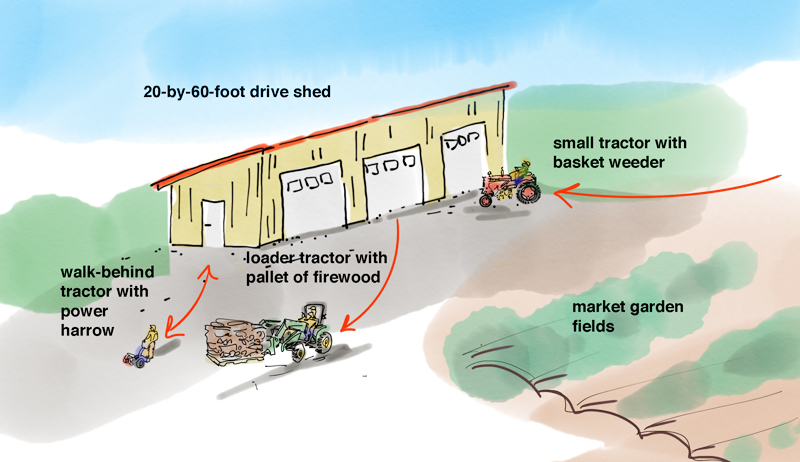
Here in Canada (and especially around Ontario), farmers are fond of a particular outbuilding design called the “drive shed.”
You may refer to this barn style by another name (or not grant it a title at all). But the drive shed can be best understood as a long storage building that has multiple bays used to store equipment, tractors, tools and supplies.
They are often built quickly and affordably by sinking large poles (4 by 4, 6 by 6, or even up to 12 by 12) into the ground 6 feet deep to serve as the footings. But the poles rise all the way to the height of the walls to serve as the main support for wall framing. They also support the beams and rafters that carry the roof.
This can eliminate the need to pour concrete. Or you can pour a concrete slab and frame the shed on top.
All in the Design
So you have plenty of options, but for the purpose of this article we will mainly discuss the design of these barns as highly accessible structures for farm tool, equipment and supply storage. The point (and reason for specific nomenclature) is their layout, door organization and overall shape compared to typical barns.
In comparison to a typical barn, the drive shed is designed to allow many pieces of equipment or loads of supplies to come in and out and keep them accessible and organized at all times.
Typical barns are usually square or rectangular. Although they can be organized for various interior operations, they can quickly get clogged when equipment is placed inside, blocking movement. Drive sheds are more often a long rectangle providing more bays with doors to move tractors in or drop supplies on pallets off.
Think of it as a long-covered row of parking spaces.
On a market garden or larger farm, this may provide a space to park several pieces of tillage equipment or a space to park the farm truck. It could serve as a spot for parking a tractor and multiple bays to receive bulk cover crop seed, and even house a wash station.
Each bay is assigned a duty, and all are accessible to the south with their own garage or sliding door.
Read more: Keep these things in mind when building a homestead barn.
Size Matters
It’s a matter of scale. You could easily design a small drive shed for a home or homestead. It could include bays for parking a driving lawn mower and a walk-behind tractor. You can organize your hand tools on the back wall of one bay. Another space could store bagged compost.
The concept remains: accessibility is key. If you cannot access your equipment and tools and supplies, you cannot stay efficient during the growing season. The drive shed, no matter the scale, keeps these items out of the weather and ready for use.
Drive sheds can be 5 feet by 15 feet, 10 feet by 30 feet, 20 feet by 60 feet…. You get it—three times longer than the depth. Usually a drive shed’s depth will not be greater than 32 feet, while continuing to be longer to integrate more bays.
Larger drive sheds can have bays with poured concrete floors and even in-floor drains to help clean up spills. You could build a smaller drive shed with packed stone or patio stones. It is up to you, your scale and budget.
But the quintessential drive shed recipe remains the same: accessibility for supplies, weather protection for tools and equipment, and an organized layout. Beyond that, the design can be up to you!
Keep growing,
Zach




